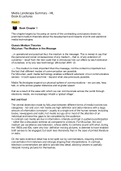Samenvatting
Media Landscape Book, Articles and Lecture Summary
- Vak
- Media Landscape
- Instelling
- Universiteit Van Amsterdam (UvA)
This extensive summary of 39 pages contains summaries to all the book chapters for each week as well as each weekly additional reading (articles) and notes to the lectures and slides. All the important theories and concepts (Example: McLuhan "Medium is the message") are explained to prepare you for...
[Meer zien]




